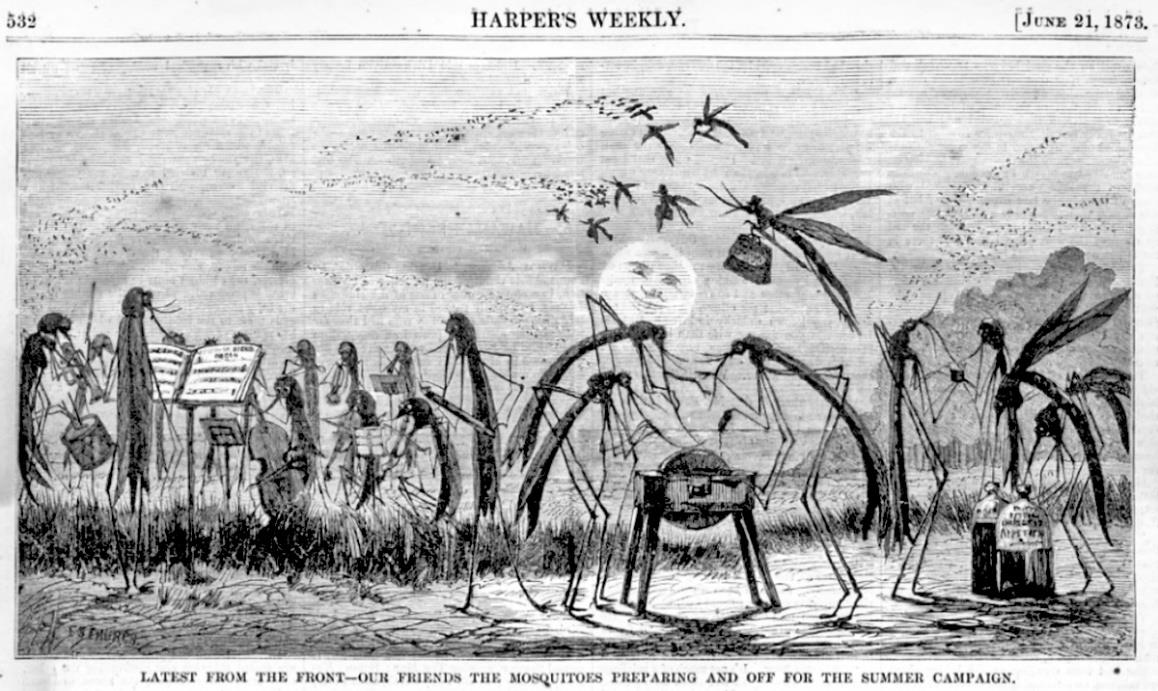Mosquitoes Win Florida Naval Battles in August 1864
(Published: February, 2021, Volume 21, Number 1, Issue #52) (Table Of Contents)(Author: Thomas Lera)
The Battles of Natural Bridge and Olustee were the only two major Civil War land engagements fought in Florida. The Union soldiers struggled with mosquitoes which invaded their tents, buzzed in their ears, fed on their blood, and generally contributed to the misery of their army life (Fig. 1).
Florida's mosquitoes waged a constant and unrelenting campaign against the Union's effort to maintain a naval blockade. As reported in the Official Records of the Union and Confederate Navies in the War of the Rebellion (ORN, 1894, 737-749) Acting Rear-Admiral, Theodorus Bailey, flag officer commanding the East Gulf Blockade Squadron from the Naval Warehouse, Key West, Florida, stated on June 19, 1862, "My worst fears have been more than realized, and for more than two months yellow fever has held its course without abatement and is worse than that of 1862 or any previous year."
John F. Van Nest, Acting Master's Mate on the US Schooner James S. Chambers, wrote in a letter home, "The weather was very warm and makes me feel very uncomfortable and millions of mosquitoes, and they almost eat me up. I can scarcely sleep at night for them. The ship is no use now, hardly enough men to man a gun. This vessel is badly ventilated, no air ports on her berth deck. There is talk of sending her home." (Van Ness, 1943)
Acting Rear-Admiral, Theodorus Bailey reported, "The disease struck every vessel in the squadron, some harder than others. On the Nita, Dale, Wanderer every person was taken sick except one or two. The Marigold, Iuka, Honduras, Honeysuckle, Huntsville, and San Jacinto have also been crippled. The provost guard of 45 men has lost more than half its numbers, and the deaths among the citizens and refugees were even greater." (ORN, 1894, 738-739)
On July 19th Acting Rear-Admiral returned north to recover from the illness and Captain Theodore P. Green took over command. By August 16th the most efficient of the squadron, The De Soto, Tioga, Tahoma, Huntsville, Merrimac, Beauregard, James S. Chambers, and San Jacinto returned north because of yellow fever. This left a mere 19 vessels in the East Gulf Blocking Squadron.
In August 1864, the US Schooner James S. Chambers was on patrol off the coast of Brevard County on the Indian River near Cape Canaveral and Mosquito Bay (now called Mosquito Lagoon). On August 5, 1864, Luther Nickerson, Acting Master Commanding reported, "an endemic broke out about 10 days ago with over one-third of the crew on the sick list. Four days later August 9th he reported two-thirds of our number are on the sick list, with four deaths."
Acting Ensign William J. Eldridge, now in Command, on August 13th reported, "the Captain and Executive Office came down with the fever. In consultation with the two surgeons and Acting Ensign C. Sears in charge of the Honeysuckle, it was decided to take the Chambers to a northern port." (ORN, 1894, 744-749)
On August 24, 1864 The U.S. Schooner James S. Chamber at quarantine, near Philadelphia William J. Eldridge Acting Ensign in Command reported, "Myself and Acting Master's Mate John F. Van Nest were the only officers fit for duty. During the passage to Philadelphia on the August 15th Captain Nickerson died. Then on August 18th Van Nest in, it is supposed, a fit of derangement jumped overboard and was drowned despite every effort to save him." One can safely say Confederate sympathizing mosquitoes were victorious in engaging the Union's East Gulf Blockade Squadron in summer of 1864 during the Civil War.
References- United States Naval War Records Office, and United States Office of Naval Records and Library. Official records of the Union and Confederate Navies in the War of the Rebellion. [ORN] Series 1, Vol 17, pp. 737-749. Washington: U.S. G.P.O., to 1922, 1894. Detailed reports from Acting Rear-Admiral, Theodorus Bailey, Commanding East Gulf Blockade Squadron, Captain Theodore P. Green, Commanding East Gulf Blockade Squadron; and Acting Ensign William J. Eldridge, in Command of US Schooner James S. Chambers.
- Ibid. pp. 738-739.
- Ibid. pp. 744-749.
- Van Nest, John F. "Yellow Fever on the Blockade of the Indian River Letters of Acting Master's Mate John F. Van Nest" Florida Historical Quarterly, Vol. 21, No. 4 (April 1943), pp. 352-357.


